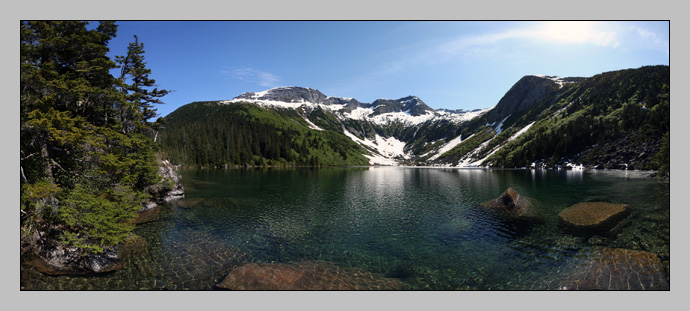
Last year Oksana and I observed Memorial Day with a few of our friends on the bank of the Taku River . It was a great weekend spent hiking, canoeing, and hiding in the cabin from bloodthirsty mosquitoes. My toy for the weekend was a new digital SLR that arrived in the mail just hours before our departure; I barely had enough time to charge the battery. I put it through its paces that weekend, though, coming close to filing the 1GB card.
On our second day there, our group decided to hike up the side of a mountain. Our goal was to have lunch on the shore of a beautiful lake where we would reward ourselves for navigating the steep, pathless trail alongside some raging river. It became a murderous death march of a hike that only gets worse with each retelling.
The mosquitoes denied us any rest breaks and the lake was still so full of snowmelt that there was no accessible shoreline — the water came right up to the trunks of the encroaching trees. After that legendary climb, new camera in hand, I wouldn’t be denied. While everyone else helped construct a tiny, smoky fire to keep the mosquitoes at bay, I fought my way down to the edge of the water and sacrificed a dry hiking boot so that I could step out onto a partially submerged rock.
I quickly set my exposure and focus points and started taking pictures. It took 40 frames to cover the entire lake, and if the mosquitoes hadn’t found my near-motionless arms and face around shot #10, I probably wouldn’t have missed the extra coverage on the bottom right. Still, I was pleasantly surprised to see the results when I stitched all 40 photos into a panorama.
Canon Digital Rebel XT
Date: 28 May 2005
Focal Length: 18mm
Shutter: 1/640 second
Aperture: F/5.6
Photoshop: Autostitch for stitching, cloning in upper left to fill in tree branches
More on the software I used after the jump:
I’ve done my fair share of stitching photos together by hand in older versions of Photoshop. It’s no fun. I’ve also tried my hand at commercial programs that automate the process somewhat. Canon provided one such piece of software with my digital camera and newer versions of Photoshop have a nifty drag-and-snap tool, too. Both pale in comparison to a little shareware application called Autostitch.
Some of Autostitch’s options are a bit esoteric, but if you’re comfortable with the default settings (which work fine 99% of the time but output at a lower-than-desirable resolution) it couldn’t be easier to use. Just drag your photos and drop them on the application’s window. You don’t even need to separate out the photos that won’t be a part of your panorama — Autostitch will figure it out.
There are times were Autostitch doesn’t do a perfect job. If your pictures were taken on a windy day, well-defined tree branches might appear blurry. I’ve seen straight-edged objects (like a sign post) get blurred, too, when the program tries too hard to correct for barrel distortion in wide angles. Where the program excels, though, is in its color and contrast blending. To illustrate, take a look at the Alpine Lake panormana when I turned those options off:

Click for larger image.
If you’ve got a PC, you might give Autostitch a try. It’s a small download, it’s free, and it does an amazing job (even on a series of hand-held photos!) There doesn’t appear to be an equivalent version as a Mac download, but a peek at their licensing information seems to indicate that a company called Kekus Digital has encorporated the Autostitch technology into a product for OS X called Calico Panorama. The Mac demo watermarks the final picture, but at least you should be able to tell if the software is worth the $39 they’re selling it for.
Give it a try. I’d love to see your results!

You must be logged in to post a comment.